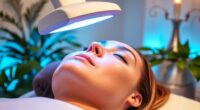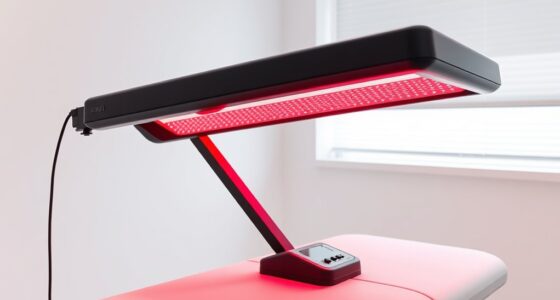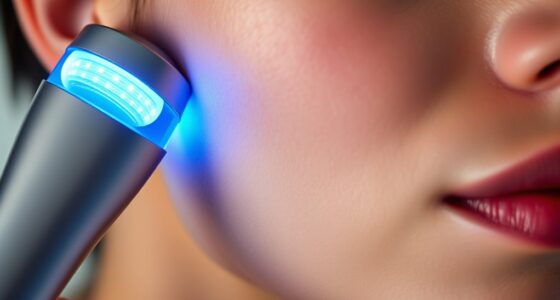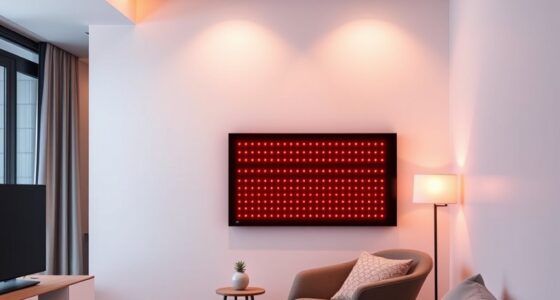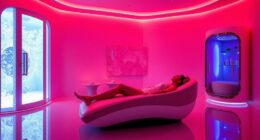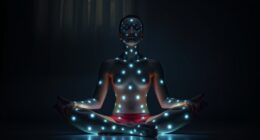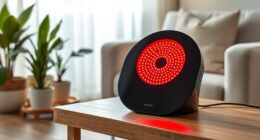LED light therapy works by using different colors of light to address specific skin concerns. Red light stimulates collagen production, reducing wrinkles and improving skin firmness. Blue light targets acne-causing bacteria, helping clear your skin. Green light reduces inflammation and pigmentation, promoting a more even skin tone. Meanwhile, yellow light enhances circulation and elasticity, while near-infrared light penetrates deeply to aid tissue repair. Each color plays a unique role in enhancing your skin's health. If you want to learn more about how these colors interact and their specific benefits, keep exploring this topic!
Key Takeaways
- LED light therapy utilizes specific wavelengths of light to stimulate cellular processes, promoting enhanced skin health and healing.
- Red light (630-700 nm) boosts collagen production, improves skin tone, and reduces wrinkles through cellular regeneration.
- Blue light (465 nm) effectively targets acne-causing bacteria, improving skin clarity and reducing breakouts.
- Green light (520-560 nm) reduces inflammation, addresses pigmentation issues, and promotes overall skin healing.
- Yellow light enhances elasticity, stimulates collagen production, and has anti-inflammatory properties to soothe skin irritation.
Understanding LED Light Therapy
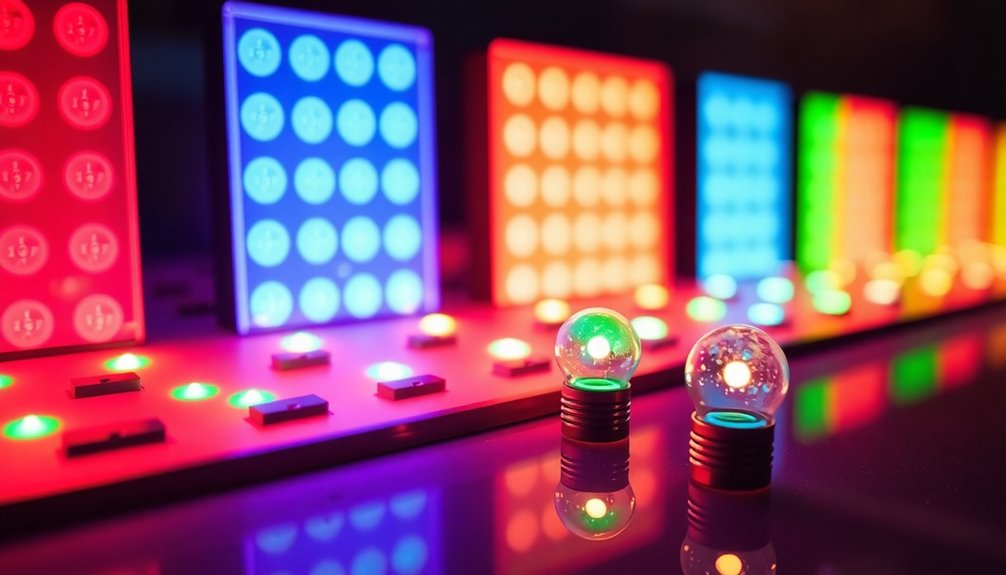
Understanding LED light therapy can transform how you think about skincare. This non-invasive treatment uses different wavelengths of light that penetrate the skin at varying depths, allowing for targeted solutions to your skin concerns. By stimulating cellular processes, it boosts collagen and elastin production, enhances tissue repair, and improves circulation, making your skin healthier. LED lights can penetrate skin at different depths for various effects, providing a versatile approach to skin rejuvenation. Additionally, the benefits of LED light therapy extend beyond just enhancing the skin’s appearance; it can also help reduce inflammation and promote healing for conditions such as acne and psoriasis. Many users report a reduction in fine lines and an overall improvement in skin tone and texture after consistent treatments. With its ability to provide a tailored experience based on individual skin needs, LED light therapy is becoming an increasingly popular choice for those seeking a more radiant and youthful complexion.
You'll find various types of LED lights, each with unique benefits—red light reduces wrinkles and promotes healing, while blue light effectively combats acne-causing bacteria. You can choose between at-home devices for convenience or professional treatments for tailored care. Whichever you select, LED light therapy offers a safe, effective way to rejuvenate your skin without thermal damage.
The Science Behind Colors
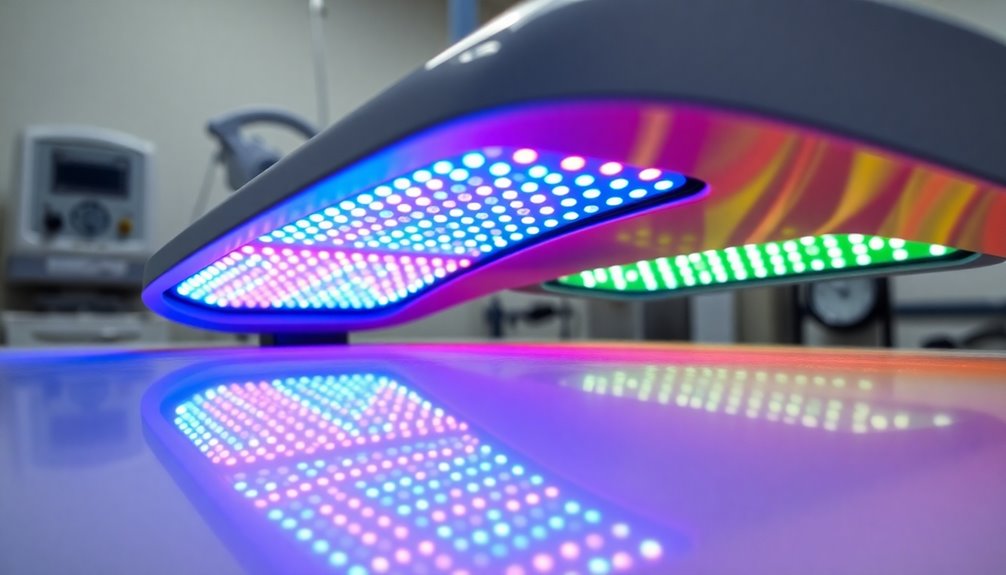
Different colors of light play a crucial role in LED therapy, each offering distinct benefits for your skin. Red light, with wavelengths between 630-700 nm, penetrates deeply to stimulate collagen production and reduce wrinkles. It's effective for conditions like rosacea and sun damage due to its ability to reach the subcutaneous layer. Additionally, red light is known for its ability to enhance skin healing by reducing oxidative stress. Blue light, around 465 nm, targets superficial layers, killing acne-causing bacteria and improving skin clarity. Green light, with wavelengths between 520-560 nm, reduces inflammation and can help with pigmentation issues. Near-infrared light, ranging from 770-900 nm, penetrates even deeper, boosting collagen production and enhancing tissue repair. Understanding these colors helps you choose the right therapy for your specific skin needs.
Red Light Therapy Benefits
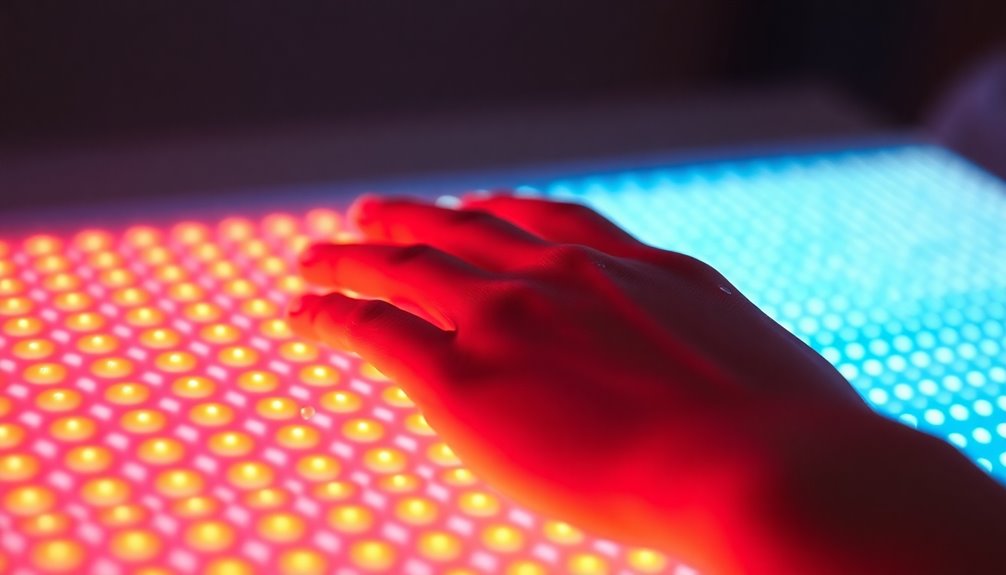
Red light therapy offers a multitude of benefits that can transform your skin and overall health. It stimulates collagen production, giving your skin a firmer, more youthful appearance while reducing wrinkles and scars. Additionally, this therapy enhances mitochondrial function, which is crucial for energy production in cells.
You'll notice an improvement in your skin tone as cellular regeneration increases and inflammation decreases. Beyond skin health, red light therapy provides pain relief by lowering inflammation and enhancing blood flow, speeding up muscle recovery and wound healing.
It also promotes mental well-being by boosting serotonin production, which can help alleviate symptoms of depression and anxiety.
Blue Light for Acne
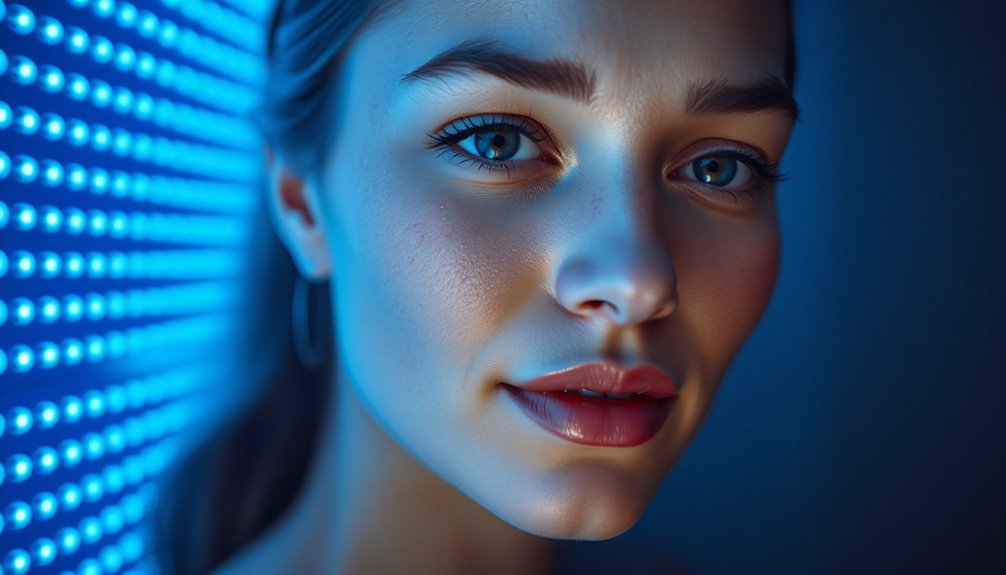
When it comes to treating acne, blue light therapy stands out as a powerful option that effectively targets the bacteria responsible for breakouts.
This therapy specifically targets Propionibacterium acnes (P. acnes) bacteria using a wavelength of 405-420 nanometers. The photodynamic reaction it triggers produces free radicals, which destroy P. acnes, reducing the likelihood of future breakouts. Regular use of glycolic acid products can also enhance skin texture and support acne treatment by removing dead skin cells and preventing clogged pores.
Blue light therapy is non-invasive and painless, meaning you won't have to worry about downtime or irritation after treatment. Typically, you'll undergo 15-minute sessions twice a week for four weeks. Studies show that many users report improved skin texture and reduced inflammation. Plus, it's FDA-approved and safe for most skin types, making it a reliable choice for acne management.
Yellow Light and Skin Health
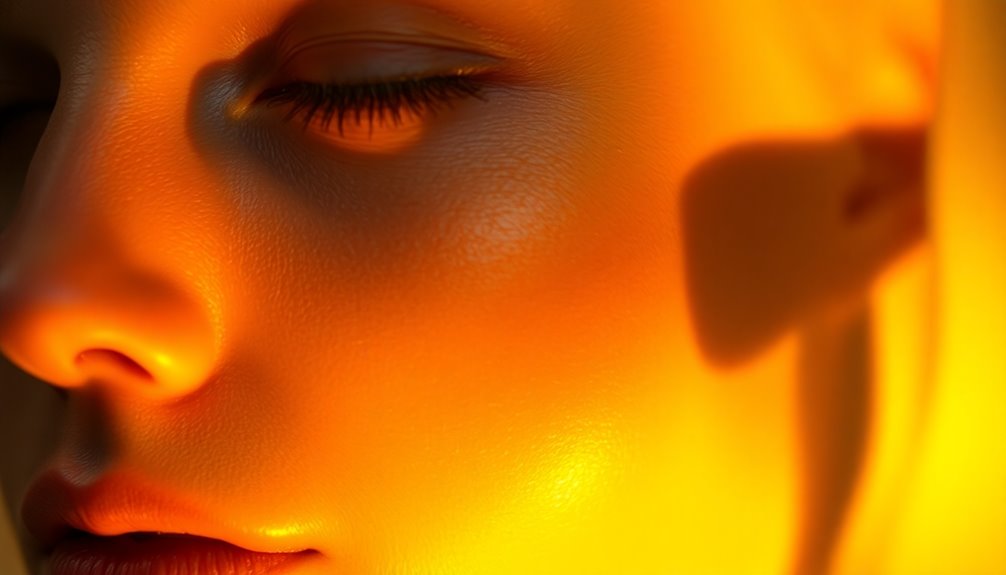
As you explore the benefits of yellow light therapy for skin health, you'll find it offers a range of rejuvenating effects.
This therapy penetrates deeply, stimulating your skin cells' mitochondria, boosting cellular energy, and enhancing your skin's natural renewal process. You'll notice improved skin texture and reduced fine lines as yellow light stimulates collagen production. This increase in collagen production contributes to enhanced elasticity, giving your skin a firmer appearance.
It also enhances circulation, delivering essential nutrients and oxygen to your skin while helping to eliminate waste. If you struggle with acne, yellow light can regulate oil production and target bacteria, reducing breakouts.
Additionally, its anti-inflammatory properties soothe irritation and redness, making it effective for conditions like rosacea.
Green Light Healing Properties
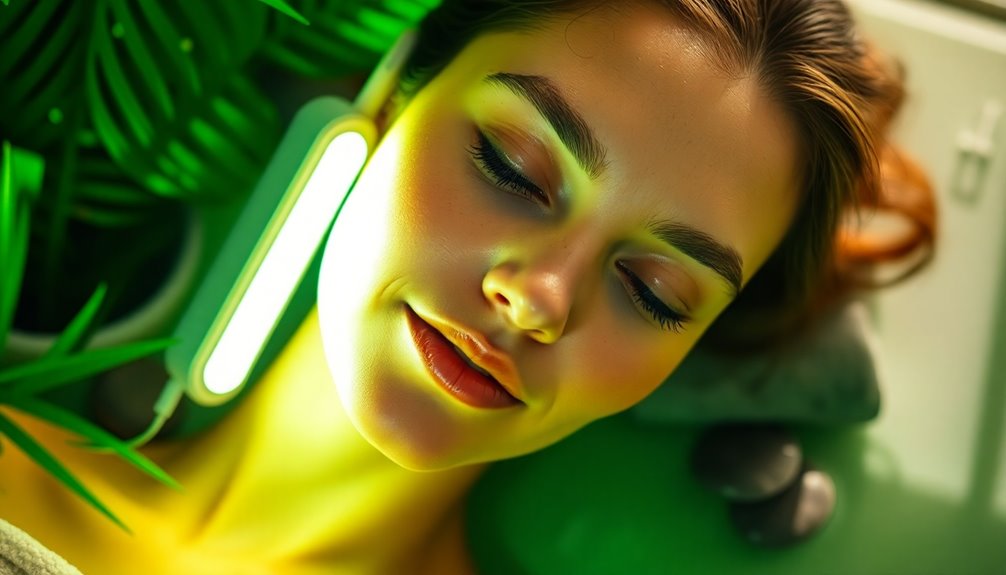
Green light therapy offers a host of healing properties that can significantly benefit both skin health and overall wellness. It stimulates collagen production, improving skin elasticity while reducing fine lines and wrinkles. You'll notice a reduction in hyperpigmentation and age spots, as it breaks down melanin clusters for a more even skin tone. Additionally, green light therapy effectively reduces inflammation, helping with conditions like acne and rosacea. Beyond skincare, it alleviates pain linked to various skin irritations and enhances circulation, speeding up tissue repair. It may even help with migraines by providing a calming effect, promoting better sleep, and regulating melatonin production. Moreover, green light therapy has been shown to aid in the healing of wounds and tissue repair, further enhancing its therapeutic benefits. Incorporating green light therapy into your routine can truly enhance your overall well-being.
Near-Infrared for Deep Tissue
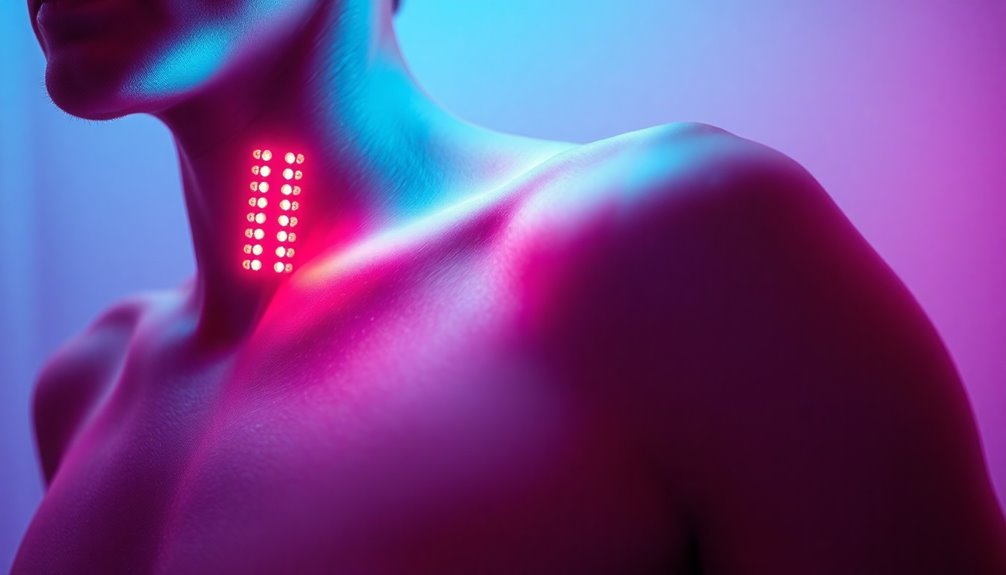
Building on the benefits of green light therapy, near-infrared (NIR) therapy takes healing a step further by penetrating deeper into your tissues. NIR light reaches depths of up to 5mm, effectively targeting muscles, joints, and even bone. It's absorbed by key molecules like hemoglobin and cytochrome c oxidase, enhancing cellular energy production and reducing oxidative stress. This therapy promotes muscle recovery, improves circulation, and significantly alleviates pain and inflammation, especially for conditions like arthritis. Additionally, NIR therapy's mechanism involves photobiomodulation (PBM), which further enhances the body's natural healing processes.
Frequently Asked Questions
How Often Should I Use LED Light Therapy for Best Results?
To get the best results from LED light therapy, you should start with 3-4 sessions a week for 4-6 weeks, each lasting 5-15 minutes.
After that, maintain your skin health by reducing frequency to once or twice a week.
If you're targeting specific concerns like acne or aging, adjust your sessions accordingly.
Just remember, consistency is key, and always consult a professional to tailor the treatment to your needs.
Are There Any Side Effects of Using LED Light Therapy?
Yes, there are side effects associated with LED light therapy. You might experience temporary redness, mild pain, or even inflammation.
Some users report photosensitive reactions, like stinging or peeling. Rarely, blistering or eye damage can occur if proper precautions aren't taken.
It's essential to consult a dermatologist, especially if you have skin sensitivity or a history of skin cancer. Always follow safety guidelines to minimize risks during treatment.
Can LED Light Therapy Be Used on All Skin Types?
Yes, you can use LED light therapy on all skin types.
It's generally safe, non-invasive, and painless, with minimal side effects like mild redness that usually fades quickly.
Whether you have sensitive or acne-prone skin, there are specific light options tailored for your needs.
Just remember to consult a dermatologist for personalized advice and follow recommended usage guidelines for the best results.
Consistency is key, so aim for regular sessions to see improvements.
How Long Does a Typical LED Light Therapy Session Last?
You might be surprised to learn that a typical LED light therapy session lasts anywhere from 3 to 20 minutes.
Most people find that 10 to 15 minutes works best for their skin concerns.
Consistency is crucial, so aim for daily or several times a week.
Depending on your skin's needs and the specific treatment, these sessions can yield noticeable improvements, making it worthwhile to stick to a regular schedule.
Is LED Light Therapy Safe for Pregnant Women?
LED light therapy is generally considered safe for pregnant women, but it's crucial to consult your healthcare provider first.
The therapy's non-invasive nature and lack of harmful UV rays minimize risks. However, be cautious about overheating, especially in the first trimester.
Avoid applying it directly to your abdomen without guidance.
Always use protective eyewear, monitor your body's response, and choose reputable devices to ensure your safety and well-being during pregnancy.
Conclusion
In the vibrant world of LED light therapy, each color shines like a brushstroke on the canvas of your skin. You can harness the healing powers of red, blue, yellow, green, and near-infrared lights to create a masterpiece of health and beauty. Imagine stepping into a sun-kissed garden, where every hue nurtures your skin, revealing its natural brilliance. By embracing these colorful therapies, you're not just treating your skin—you're illuminating your path to wellness.

